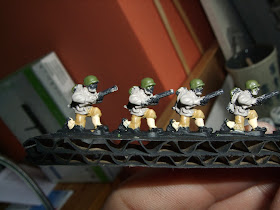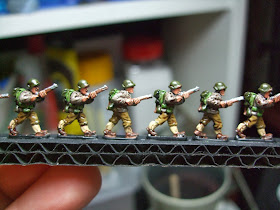I decided to paint them up to sell on. I'd recently picked up a set of Cote D'arms WW2 US paints for my NVL 15mm Scifi troops. These are the same formulation as the original Citadel paints, which was what I cut my painting teeth on, so I was keen to try them out.
I worked out basic equivalences between the colours and my usual GW paints (this was before I switched to Vallejo - I'm such a paint floozy) based on a colour chart in the old FOW US handbook.
The figures were all glued to strips of corrugated cardboard and undecorated GW Chaos Black. The aim was to get an entire company, 3 platoons of 9 stands of 4 men with command, HQ and bazooka stands too. Just under 130 figures in all. By far the most figures I'd painted in one go. With this in mind I decided that the painting standard would be gaming quality - base colours and a wash. I'd never used the "dip" method before, although I do have a tin of unopened Army Painter Strong Tone, but I had heard good results could be achieved with brown ink. I picked up a bottle of Windsor and Newton Peat Brown for this project.
Each figure was block painted with the base colours on a production line, so all the jackets were done first, then the trousers and so on. I grouped the poses together, facing the same way, and worked out a way to paint the figure efficiently with the first in a group, and just repeated the process as I went along. I painted the large areas first, so that I didn't have to be super-precise, as everything else would be painting on each successive colour would be covering up any mistakes I had already done.
 |
| Step 3 - (photos for steps 1 and 2 were just too dark to see). Field drab jackets, tan earth trousers already painted. Olive Green helmets, grenades and entrenching tool covers. |
 |
| Pale sand leggings added |
 |
| Flesh - it's at this point that a figure starts to look like a little person and not a hunk of lead, in my opinion. |
 |
| Beige Brown added for boots, wooden stocks on weapons, entrenching tool handle, pistol holsters and knife sheath. Metallic gunmetal for the rifle barrel, MG's and SMG's. |
I used a Humbrol metallic on these figures, as it was quite a nice pewter/gunmetal in the pot - sort of like a GW Leadbelcher before Leadbelcher was available - but discovered that it took AGES to dry. To avoid the ink diluting the metallic and causing my US troops to get a sparkly makeover, I left the figures to dry overnight.
Next day the figures got a generous wash of undiluted peat brown ink. As i discovered, with ink, a little goes a long way. One dip in the pot usually had enough ink to do 8 or 9 figures. I tried not to let it pool anywhere, but seep into the cracks and crevices on the figures.
 |
| Lots of little dudes. |
The figures were then based on standard FoW bases and Windsor and Newton coarse texture medium was mixed with W&N Burnt Umber. the mix had some fine ground cork added to it and was then plastered onto the bases. Uncovered areas were touched up with W&N burnt umber, which was then lightly dry brushed with GW Bestial Brown and Dheneb Stone. Flock and small sections of static grass clumps were added and the whole thing was given two coats of GW Purity Seal, followed by Testors Dullcoat to take away the shine.
Each of the 3 platoons was differentiated by some detail on the base. One platoon had just flock and clumps, one had a small cork boulder added and one had a piece of clump foliage added. HQ squad got two small boulders.
I'm really pleased with how they came out. For four evenings work I'm very impressed at what I have achieved. It's slightly irritating that I didn't take the time to paint them whilst we were still playing Flames of War, but I'm going to use the same technique on the US airborne platoon I have for Bolt Action/Chain of Command.


















Very nice tuto, looking good!
ReplyDeleteVery cool. I'm doing a very similar thing with PSC 15mm Germans. It's somewhat grueling, but it will feel good when it's done.
ReplyDeleteYour basing looks nice. Are you playing CoC with 6mm or 15mm?
The worst thing about quick and dirty painting, is that often the results are better than the models you were laboriously painted for hours at a time.
ReplyDelete"Flesh - it's at this point that a figure starts to look like a little person and not a hunk of lead, in my opinion."
ReplyDeleteI looooove that moment :D
Good job painting a ludicrous number of figures! The dip was an excellent choice in this case, that's for sure.
Itinerant - It'll be in 15mm with individually based figures. I'm re-purposing some of my FOW support weapons and using a US airborne platoon that I bought at the same time as these guys.
ReplyDeleteGreat looking Pig Platoon!
ReplyDeleteNice work.
ReplyDeleteBTW, I've added it to the list of painting guides that I curate at my blog, Spotting Round. I think that the Spotting Round guide to painting guides is pretty good, and I keep adding links as I find them (like yours. Two years after its posted...)
I saw your German quick and dirty article too and will incorporate it as well. Keep on painting!